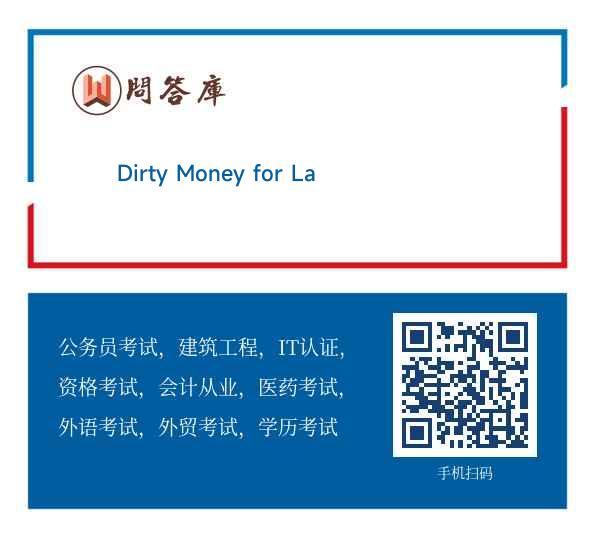Dirty Money for Laundries Selling illegal drug
问题详情
Dirty Money for Laundries
Selling illegal drugs is big business and laundering the proceeds an art form. One kilogram, or 2.2 pounds, of raw coca leaves is worth $1,400 in Latin America. By the time it is turned into refined cocaine, its value has grown to $100,000. Making the money appear to have come from a legitimate source that can create a paper trail spanning dozens of countries, and a web of financial transactions that may be impossible to unravel.
The United Nations has estimated that between $120 billion and $500 billion is laundered each year in the industrial world bigger than the volume of the oil trade.
Illegally obtained money is difficult to openly spend and invest: Drug cash often consists of large volumes of mixed denomination notes; the physical volume of notes can be far larger than the volume of the drugs themselves. Performing large transactions without arousing suspicion is the launderer"s principal hurdle.
Different countries have different disclosure requirements, and the launderer seeks to exploit that by moving money between jurisdictions and covering up the audit trail. Terry Burke of the National Drugs Intelligence Unit in Britain said: "The big cases are so international in scale, and it can be very difficult to lift the veil of secrecy."
Investigators have identified three main stages in the laundering process.
In the first stage, the money can be deposited in a legitimate premium life insurance policy. Or the cash can be used to buy "art, jewelry, antiques or gambling chips.
The second stage is called "layering". The launderer wants to separate his illicit proceeds from their source so he enters into a large number of financial transactions designed to disguise the trail and provide anonymity.
Finally, there is "integration". If the layering has been successful, the launderer will bring the money back into the economy in such a way that it appears to be normal business funds. So, an art object will be sold, a life insurance policy redeemed, and so on.
The BCCI scandal is a classic instance of drug-related financial abuse. With total assets in 1988 of $20 billion and 417 branches in 73 countries, BCCI was considered the seventh-biggest private bank in the world. In its case, prosecutors alleged that one scheme it operated was to collect cash in various American cities, which was deposited. The money was then transferred by wire to BCCI accounts abroad and used to buy certificates of deposit that acted as collateral for BCCI "loans" to the drug traffickers, supplying them with "clean" money.
Another money laundering investigation in the United States and Britain, code-named Operation Cougar, has so far identified $318 million of "dirty" money. The laundering operation spanned the Isle of Man, the British Virgin Islands and the U.S. mainland, and involved seven drug dealing organizations. At the center of each organization was a lawyer who coordinated the movement of money between offshore bank accounts, shelf companies and nominee directors.
One trick was to use the organizations" offshore companies to mortgage property. On the face of it, the paper trail was legitimated--the mortgage was bona fide, and interest payments were met. But as the financial layers were peeled back, the illicit origin of the money became apparent. So far, Operation Cougar has resulted in the imprisonment of 40 people.
One method that has come to the attention of the authorities more recently is the launderers" use of Hawala banks family-run businesses offering money transmission services, Interpol became sufficiently worried to mount a two-day conference on the subject earlier this year. Hawala originates in Asia and is basically a system of letters of credit, providing a legitimate channel for the movement of money from one area to a
A.Y
B.N
C.NG
参考答案
正确答案:B
解析:本题的关键词为that of petroleum,由此可知把本题定位到第2段,此处李代桃僵,The volume of drugs consumed替换了between $120 billion and $500 billion is laundered,答案显然为N。
